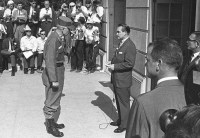The Stand In The Schoolhouse Door
It was fifty years ago today – June 11, 1963. I was a witness to a piece of history that, as much as anything, propelled me into a career in journalism.
The University of Alabama, where I was a student, was until that moment a segregated institution. There had been one earlier attempt to integrate, but it ended in mayhem. Now, on this day fifty years ago, two black students – Vivian Malone and James Hood – appeared to register for classes. Governor George Wallace physically blocked their way, a piece of theatre that came to be known as “the stand in the schoolhouse door.”
Wallace had run for Governor, and won, on a segregationist platform, and it had backed him into a corner. The University would be integrated, there was no doubt about that, but Wallace needed political cover. So the “stand” was carefully orchestrated. U.S. Attorney General Robert Kennedy and his aides worked out the scenario: Wallace would make a symbolic stand, the Alabama National Guard would be federalized, and when the Guard showed up, Wallace would stand aside. Everything went as planned. Wallace made his show, the students enrolled, and violence was averted.
I was working my way through college at a Tuscaloosa radio station at the time, and beginning to cover local news stories. This was the biggest. I was there, notepad and tape recorder in hand, in the throng of local and national press people several yards from Wallace on the steps of Foster Auditorium. At the moment, my only thought was the story itself . But in the days ahead, I had time to reflect on the moment and consider it from the perspective of a University student. I had the unshakeable conviction that Vivian Malone and James Hood – citizens of my state – had every right to be students at my school. And I thought Governor Wallace had used my school as a stage for political grandstanding.
A couple of years later, I graduated and took a job as a reporter for a Montgomery television station, covering the state capitol and state politics. Governor Wallace and I had a cordial relationship – reporter and newsmaker. I came to understand his multi-faceted personality. He was, in a sense, trapped by his own political rhetoric. But he had a populist and compassionate streak, too. He helped created a system of trade schools and junior colleges across Alabama, and championed a free textbook program for elementary and secondary school kids. There was light and dark in George Wallace, as in us all.
The “stand in the schoolhouse door” was my first big story. It convinced me that I was on the right career path, and I never looked back. I came to believe that a good journalist needs three things: integrity, curiosity, and a love of the power of words – to inform, enlighten, entertain, and even disturb. I have George Wallace to thank for at least some of that.
